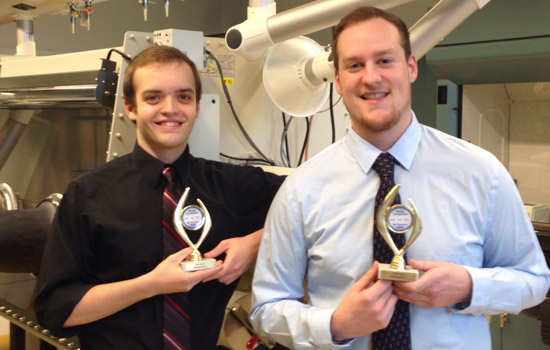Students take second in engineering competition
Students’ work on novel uses of carbon nanotubes for wastewater treatment is highlighted
Provided by Reginald Rogers
Chemical engineering undergraduates Jared Benton-Smith, left, and Tyler Sherwood took second place in the student research poster contest, part of the annual meeting of the American Institute of Chemical Engineers.
Research by students at Rochester Institute of Technology to improve use of carbon nanotubes as a possible solution to filter and remove materials from wastewater was recognized at the 2013 Undergraduate Student Poster Competition, part of the annual meeting of the American Institute of Chemical Engineers.
Tyler Sherwood and Jared Benton-Smith, both undergraduates in RIT’s Kate Gleason College of Engineering, were each awarded second place in the student research-poster competition. Sherwood was recognized for “Adsorption properties of single-wall carbon nanotube-graphene hybrid papers for the removal of organic compounds from aqueous environments.” Benton-Smith took honors for “Recycling of carbon-based adsorbents through desorption compounds.”
More than 200 students from U.S. colleges and universities participated in the competition focused on undergraduate research in areas such as sustainability, biotechnology, fuels, petrochemicals and energy.
Overall, the work details their research on the production of a carbon nanotube-graphene hybrid paper that is used for water treatment, says Sherwood, a third-year chemical engineering student from Fonda, N.Y. In his work specifically, the introduction of graphene makes the process more cost effective and increases the adsorption rate and overall capacities over single-wall carbon nanotubes alone.
“Currently, activated carbon is the standard for waste water treatment, but carbon nanotubes can adsorb at a much faster rate and have a higher capacity than activated carbon,” he explains. “They are expensive though, so a hybrid paper is made combining the single-wall carbon nanotubes with graphene nanoplatelets that are much cheaper.”
Benton-Smith’s related work involved removing pollutants from the saturated hybrid papers through thermal and microwave treatments. The desorption process increased the maximum capacity of the papers, pollutants were removed and the quality of the material was improved.
“My findings were critical in the practical implementation of this new class of adsorbents,” he adds. “Since carbon nanotubes are extremely expensive, a means of recycling these materials is required for them to be a reasonable replacement to the cheap, standard adsorbent, activated carbon.”
Carbon nanotubes are structures of bonded carbon atoms, shaped into tube-like forms. Single-wall nanotubes are a few nanometers, or a hundred-thousandth the width of human hair. Graphene is a form of carbon, typically found in single, flat layers. The combination of materials has been found to provide increased strength, flexibility and conductivity for products such as sensors, flexible and consumer electronics, and optical devices, for example. Sherwood and Benton-Smith, a third-year student from Higganum, Conn., have been working closely with faculty member Reginald Rogers, assistant professor of chemical engineering, on adsorption with carbon nanotubes for use in wastewater treatment facility processes.
“Tyler and Jared have done extensive work associated with the development of hybrid structure as well as understanding the adsorption and desorption properties of the novel adsorbent,” says Rogers, who leads the Nanoscale Energy and Separation Research Lab in the engineering college. His research focuses on the development of next-generation adsorption materials, primarily composed of carbon nanomaterials, including graphene and carbon nanotubes. Development of the latter hybrid materials for adsorption has demonstrated significant improvements in the adsorption uptake of organic materials.
“Carbon nanotubes and hybrid films provide a faster and higher adsorption capacity that can improve all filtration units in industry, not only in waste water but in air filtration and as sensors possibly,” says Sherwood.














